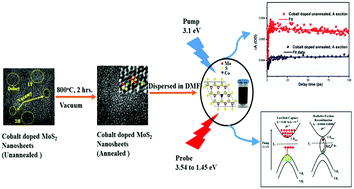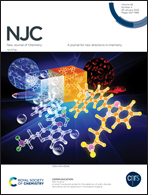One order enhancement of charge carrier relaxation rate by tuning structural and optical properties in annealed cobalt doped MoS2 nanosheets†
Abstract
The effective manipulation of excitons is crucial for the realization of exciton-based devices and circuits, and doping is considered a good strategy to achieve this. The influence of high temperature (800 °C) and vacuum annealing on the structural, morphological, optical properties and charge carrier dynamics of various percentages of hydrothermally-synthesized cobalt (0%, 2%, 4% and 8%) doped Molybdenum disulfide (MoS2) nanosheets are investigated. It has been confirmed by X-ray diffraction that the annealed samples exhibit better crystalline quality with (002) preferential direction. The prominent presence of mixed phases (2H and 1T), sulfur vacancies and strain due to sulfur vacancies in unannealed samples have been affirmed by Raman spectroscopy, XPS and HRTEM measurements, whereas the thermodynamically stable 2H phase predominates in the annealed samples. A, B and C excitons are observed through optical UV-Vis spectroscopy and their photo-induced charge carrier dynamics are studied through transient absorption spectroscopy. Predominant excited state absorption (ESA) overwhelms the saturable absorption effect arising from the state-filling of excitonic levels in the case of unannealed samples. Reduction of the 1T phase and defects leads to the absence of ESA in the annealed samples and regulated defect-assisted carrier recombination contributed from doping is found to dominate the differential absorption (ΔA) at excitonic resonance. A fascinating one order enhancement in the relaxation rate of hole capture corresponding to B excitonic transition (k = 0.08 ± 0.009 to k = 0.7 ± 0.05 ps−1) has been explored with the increase of cobalt dopant amount from 0% to 8% with the introduction of more recombination centers in the annealed samples. Our findings establish that cobalt doping in layered TMD materials with high-temperature vacuum annealing conditions enables controlled tuning over exciton dynamics. Control over such excitonic properties facilitates the efficient design of exciton-based optoelectronic devices in the future.



 Please wait while we load your content...
Please wait while we load your content...